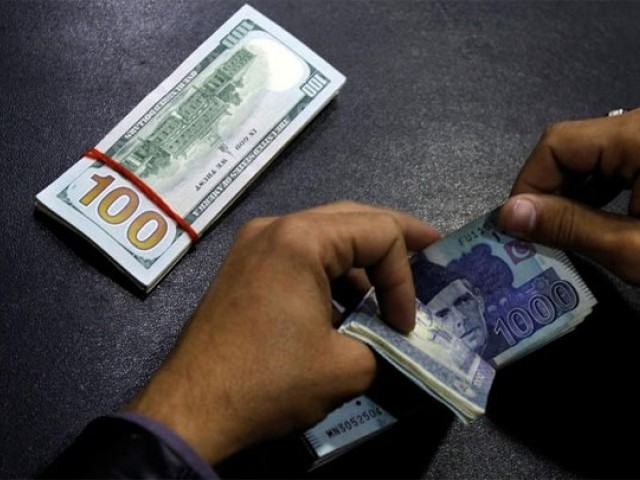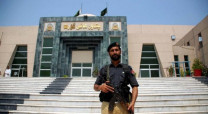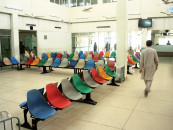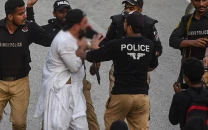Rupee weakens to 162.16 ahead of IMF board meeting
Speculation comes true as rupee enters 160-165 range against dollar

PHOTO: REUTERS
The rupee weakened 3.3%, or Rs5.18, in a single day and closed at an all-time low of Rs162.16 to the US dollar in the inter-bank market compared to Tuesday’s close of Rs156.98, the State Bank of Pakistan (SBP) reported.
Earlier, the rupee hit an intra-day low at Rs164.50, according to market sources.
The market speculated that the rupee would drop to Rs160-165 when the IMF team visited Islamabad in March 2019.
“The rupee was hovering around Rs139-140 when the IMF team arrived in March 2019,” Forex Association of Pakistan (FAP) President Malik Bostan recalled. BankIslami President and CEO Syed Amir Ali was of the view that “stability will return to the currency market after Pakistan formally enters the IMF loan programme.”
The IMF executive board is scheduled to meet next Wednesday (July 3) to consider Pakistan’s loan programme worth $6 billion after Islamabad agreed to meet all the commitments made to the fund in a staff-level agreement in May 2019. Government officials, including Adviser to PM on Finance Dr Abdul Hafeez Shaikh, however, have denied several times that the government have agreed to any fixed rupee-dollar parity under the IMF programme.
The commitment the government made was that it would end state control of the rupee and let market forces - which mostly comprise banks - decide the rupee-dollar parity keeping in view the demand and supply of dollars.
The rupee has so far lost 9.62%, or Rs14.24, in the current month. Since the beginning of outgoing fiscal year, the rupee has cumulatively dropped 33.5%, or Rs40.67, from Rs121.49 on first working day of the year on July 3, 2018.
“The rupee came under pressure apparently due to (large) foreign debt repayments before the current fiscal year ends on June 30, 2019,” said Topline Securities CEO Muhammad Sohail.
Rupee recovers in inter-bank
Other large international payments the country is scheduled to make include petroleum oil import payments. Besides, the corporate sector is buying dollars to settle their accounts ahead of the close of FY19. At present, Pakistan’s foreign currency reserves stand insufficient at only $7.6 billion.
Last week, State Bank of Pakistan (SBP) Governor Dr Reza Baqir said, “The recent depreciation of the rupee is seasonal.” This is a seasonal pattern as several companies need dollars to make international payments ahead of the closure of their yearly books on June 30, he said.
Depreciation makes no sense
Alpha Beta Core CEO Khurram Schehzad said “this kind of devaluation of currencies never makes sense because it will only burden the government with more debt, people with more inflation and industries with high cost and no export growth; resultantly strangulating the economy.”
Bostan, on the other hand, said “Pakistan is going through worse economic times. There is apparently no strategy at the government level to deal with the emerging poor economic situation.”
SBP official rules out further depreciation of rupee
Economic sovereignty and security were in danger, he said. “The government has to control the rupee-dollar parity at some point,” he suggested. “Otherwise, the new mechanism put in place for finding a suitable rupee-dollar level, linked with demand and supply of dollars, may take the exchange rate to anywhere,” the Forex association president said. He said the government had just let the rupee depreciate and practically done nothing to increase dollar supply in the market to curtail demand.
“Currency dealers have suggested a number of options to the government to increase dollar supply and reduce demand,” he said, adding, however, it adopted none of them.
The options include using local currencies for trade with the largest trade partner China as earlier the two countries have signed a currency swap agreement. The government also did not ban the import of unnecessary and luxury items, he pointed out. Importers have continued to open letters of credit for imports at zero advance payment, which has increased demand for dollars in the inter-bank market.
Gold hits all-time high
The massive depreciation of the rupee prompted the gold pricing committee of the All Sindh Saraf and Jewellers Association (ASSJA) to increase the price of the precious metal by Rs500 to a new all-time high at Rs81,000 per tola (11.66 grams) on Wednesday.
The increase came despite a significant drop of $25 to $1,404 per ounce (31.10 grams) in the London gold market.
Published in The Express Tribune, June 27th, 2019.
Like Business on Facebook, follow @TribuneBiz on Twitter to stay informed and join in the conversation.


















COMMENTS
Comments are moderated and generally will be posted if they are on-topic and not abusive.
For more information, please see our Comments FAQ